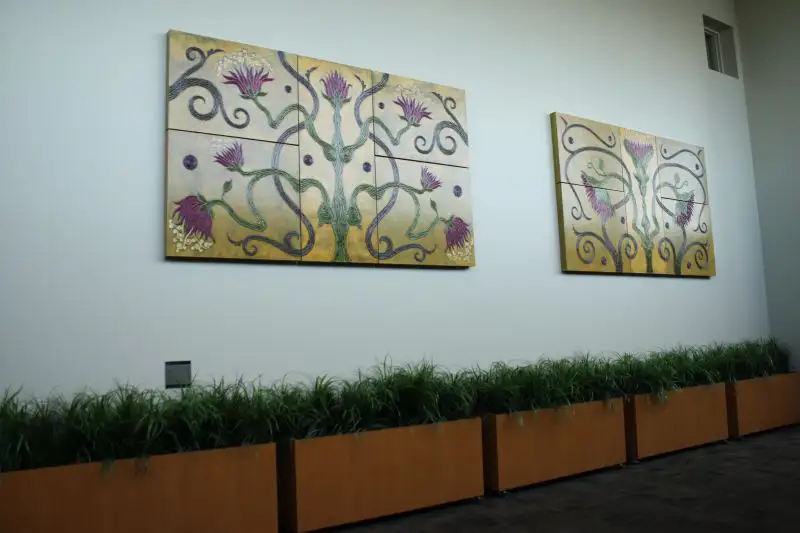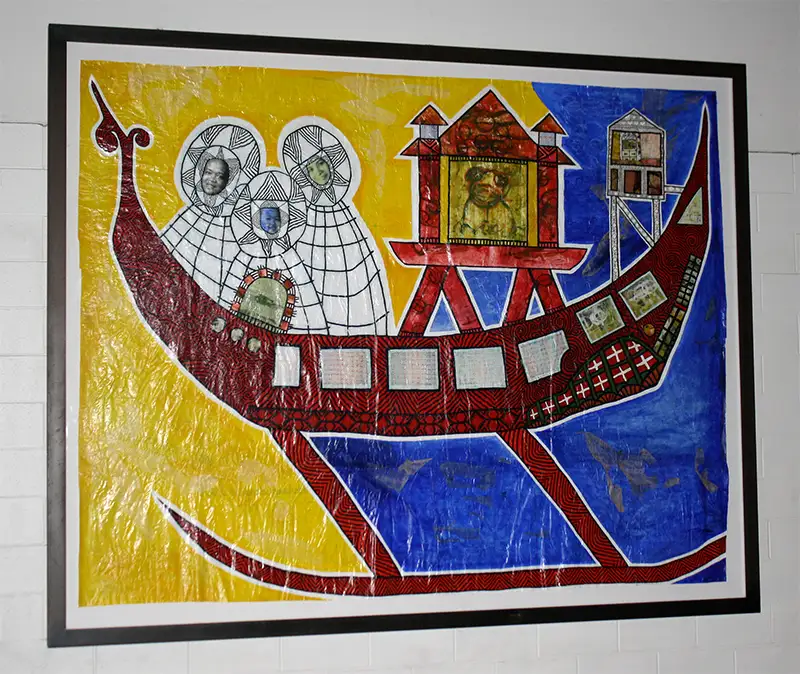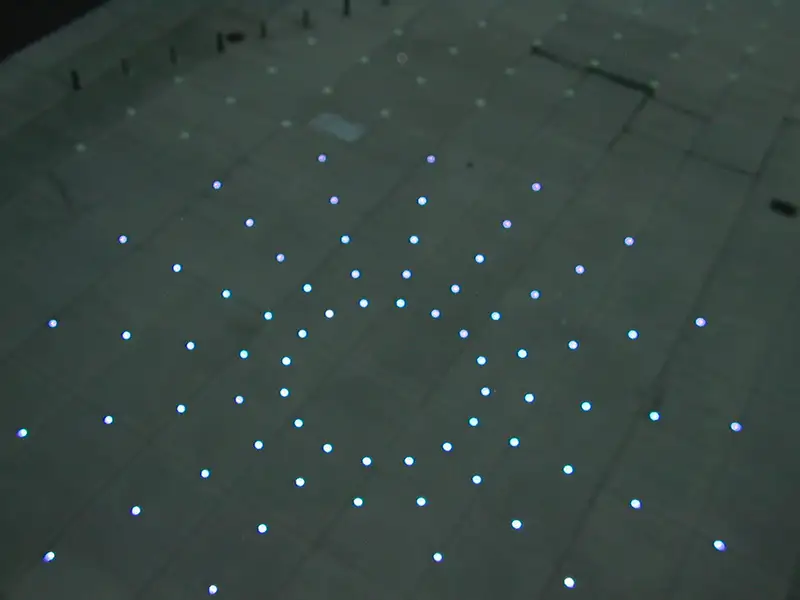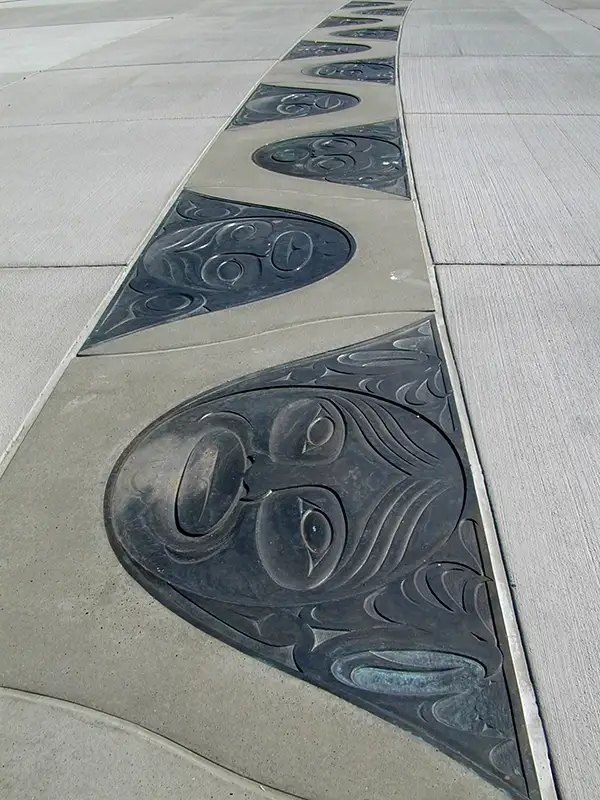
Public Art
The Stadium and Exhibition Center Art Program was launched in 1998, enabled by a voluntary $1.75 million contribution from First & Goal Inc. In 1998, a request for qualifications yielded a total of 254 responses from around the United States and Canada. The artists featured in the program were selected by a 11-member Art Selection Committee.

Four Zones
Four Zones (2001) - Juan Alonso, Seattle
Mr. Alonso produced a series of four paintings, each measuring 6′ tall and 10′ wide. The paintings depict floral imagery, for which the artist is known, and are exhibited at the south entrance of the Club level in the Stadium.

Point-Grate
Point-Grate (2002) - Susan Point, Vancouver, British Columbia, Canada
Ms. Point’s artwork for the stadium consists of two distinct projects; a band of cast bronze bas-relief sculptures at the base of the North Tower and all the tree grates for the entire Stadium & Exhibition Center. The pattern of bronze bas-relief sculptures at the base of the North Tower (in an arc that outlines a portion of the former footprint of the Kingdome) is composed of four designs intended to represent world cultures. The tree grate designs are based on the designs of spindle whorls-stone flywheels attached to the tools the Salish used for spinning yarn.

Populi
Populi (2001) - David Russo, Seattle
Mr. Russo created moving video imagery reflecting the textures of our surrounding region in a loose, non-linear narrative that permits “entering” the piece at any time. This imaginative time-based work has been featured on the internal media system of the Stadium.

Rockshadow
Rockshadow (2002) - Peter Shelton, Malibu, California
On the West Plaza along Occidental Avenue, Mr. Shelton installed a work titled “Rockshadow.” The installation includes a large Northwest boulder approximately eight to 10 feet in diameter, and weighing 35,000-65,000 pounds, which reflects the geological origins of our region. A bronze cast of the rock or “shadow” has been placed near the rock.

10 Gelatin Silver Prints all Uniquely Named
by Glenn J. Rudolph, Seattle
Working in large format black and white photography, Mr. Rudolph focused primarily on the Duwamish River. When shown together, his 10 photographs tell the story of the changing face of this Northwest landscape.

Barangay
Barangay (2001) - Romson Egarde Bustillo, Seattle
Mr. Bustillo’s three large-scale paintings are from an ongoing series of works exploring contemporary and historic Filipino culture. The works are featured in the corridor between the Exhibition Center and the Stadium.

Lumen
Lumen (2002) - Belize Brother, Seattle
Ms. Brother, well known for her use of light as an art form interacting with architecture, created a geometric design using lights embedded in the concrete in the North Plaza. Mainly seen at night, the work will provide a stimulating focus within the North Plaza for patrons and the surrounding community.

Earth Dialogue
Earth Dialogue (2002) - Bob Haozous, Santa Fe, New Mexico
Mr. Haozous’ installation of the stadium’s North Tower is assembled from four 24-foot diameter painted steel discs. Although inspired by symbols that are part of his Warm Springs/Chiricahua Apache heritage, Haozous believes that the forms and colors of the artwork have universal meanings. Specifically, the artwork is intended as a constant reminder of our deep connection to the earth. According to Haozous, the lowest disc, depicting a stylized cityscape, represents our contemporary, man-made world. The green disc above it symbolizes life and growth, but its human figures are flying away, suggesting the loss of man’s direct tie to nature, or in a more hopeful reading, a return to those ties. The third disc honors the sun, highlighting our depended on the natural world and the redemptive powers of nature. The top disc is a collection of man-made clouds, meant to suggest the immensity of the natural environment.

Point-Face
Point-Face (2002) - Susan Point, Vancouver, British Columbia, Canada
Ms. Point’s artwork for the stadium consists of two distinct projects; a band of cast bronze bas-relief sculptures at the base of the North Tower and all the tree grates for the entire Stadium & Exhibition Center. The pattern of bronze bas-relief sculptures at the base of the North Tower (in an arc that outlines a portion of the former footprint of the Kingdome) is composed of four designs intended to represent world cultures. The tree grate designs are based on the designs of spindle whorls-stone flywheels attached to the tools the Salish used for spinning yarn.

The Stadium Suite
The Stadium Suite - Cheryl dos Remedios, Seattle
Eight of Ms. dos Remedios’ paintings have been reproduced as banners and are displayed in front of the Lumen Field Event Center. Her work reflects playfully on the full range of visual stimuli in the building.

Colossal Heads
Colossal Heads (2002) - Claudia Fitch, Seattle
Ms. Fitch created the six “Colossal Heads” mounted on the central columns of the stadium’s west colonnade along Occidental Avenue. The heads, all between 6 and 7 feet in height are a idiosyncratic interpretation of images from a variety of eras and cultures.
Public Art
The Stadium and Exhibition Center Art Program was launched in 1998, enabled by a voluntary $1.75 million contribution from First & Goal Inc. In 1998, a request for qualifications yielded a total of 254 responses from around the United States and Canada. The artists featured in the program were selected by a 11-member Art Selection Committee.
Juan Alonso, Seattle
Four Zones, 2001
Mr. Alonso produced a series of four paintings, each measuring 6′ tall and 10′ wide. The paintings depict floral imagery, for which the artist is known, and are exhibited at the south entrance of the Club level in the Stadium.
Susan Point, Vancouver, British Columbia, Canada
Point-Grate, 2002
Ms. Point’s artwork for the stadium consists of two distinct projects; a band of cast bronze bas-relief sculptures at the base of the North Tower and all the tree grates for the entire Stadium & Exhibition Center. The pattern of bronze bas-relief sculptures at the base of the North Tower (in an arc that outlines a portion of the former footprint of the Kingdome) is composed of four designs intended to represent world cultures. The tree grate designs are based on the designs of spindle whorls-stone flywheels attached to the tools the Salish used for spinning yarn.
David Russo, Seattle
Populi, 2001
Mr. Russo created moving video imagery reflecting the textures of our surrounding region in a loose, non-linear narrative that permits “entering” the piece at any time. This imaginative time-based work has been featured on the internal media system of the Stadium.
Peter Shelton, Malibu, California
Rockshadow, 2002
On the West Plaza along Occidental Avenue, Mr. Shelton installed a work titled “Rockshadow.” The installation includes a large Northwest boulder approximately eight to 10 feet in diameter, and weighing 35,000-65,000 pounds, which reflects the geological origins of our region. A bronze cast of the rock or “shadow” has been placed near the rock.
Glenn J. Rudolph, Seattle
10 Gelatin Silver prints all Uniquely Named
Working in large format black and white photography, Mr. Rudolph focused primarily on the Duwamish River. When shown together, his 10 photographs tell the story of the changing face of this Northwest landscape.
Romson Egarde Bustillo, Seattle
Barangay, 2001
Mr. Bustillo’s three large-scale paintings are from an ongoing series of works exploring contemporary and historic Filipino culture. The works are featured in the corridor between the Exhibition Center and the Stadium.
Belize Brother, Seattle
Lumen, 2002
Ms. Brother, well known for her use of light as an art form interacting with architecture, created a geometric design using lights embedded in the concrete in the North Plaza. Mainly seen at night, the work will provide a stimulating focus within the North Plaza for patrons and the surrounding community.
Bob Haozous, Santa Fe, New Mexico
Earth Dialogue, 2002
Mr. Haozous’ installation of the stadium’s North Tower is assembled from four 24-foot diameter painted steel discs. Although inspired by symbols that are part of his Warm Springs/Chiricahua Apache heritage, Haozous believes that the forms and colors of the artwork have universal meanings. Specifically, the artwork is intended as a constant reminder of our deep connection to the earth. According to Haozous, the lowest disc, depicting a stylized cityscape, represents our contemporary, man-made world. The green disc above it symbolizes life and growth, but its human figures are flying away, suggesting the loss of man’s direct tie to nature, or in a more hopeful reading, a return to those ties. The third disc honors the sun, highlighting our depended on the natural world and the redemptive powers of nature. The top disc is a collection of man-made clouds, meant to suggest the immensity of the natural environment.
Susan Point, Vancouver, British Columbia, Canada
Point-Face, 2002
Ms. Point’s artwork for the stadium consists of two distinct projects; a band of cast bronze bas-relief sculptures at the base of the North Tower and all the tree grates for the entire Stadium & Exhibition Center. The pattern of bronze bas-relief sculptures at the base of the North Tower (in an arc that outlines a portion of the former footprint of the Kingdome) is composed of four designs intended to represent world cultures. The tree grate designs are based on the designs of spindle whorls-stone flywheels attached to the tools the Salish used for spinning yarn.
Cheryl dos Remedios, Seattle
The Stadium Suite
Eight of Ms. dos Remedios’ paintings have been reproduced as banners and are displayed in front of the Lumen Field Event Center. Her work reflects playfully on the full range of visual stimuli in the building.
Claudia Fitch, Seattle
Colossal Heads, 2002
Ms. Fitch created the six “Colossal Heads” mounted on the central columns of the stadium’s west colonnade along Occidental Avenue. The heads, all between 6 and 7 feet in height are a idiosyncratic interpretation of images from a variety of eras and cultures.



